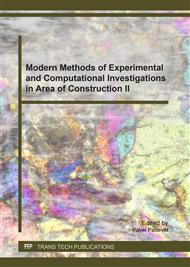p.97
p.102
p.109
p.115
p.121
p.128
p.136
p.142
p.148
Microstructure-Based Evolution of Compressive Strength of Blended Mortars: A Continuum Micromechanics Approach
Abstract:
The evolution of stiffness and strength belong to the most important properties of mortars. Motivated by an increasing demand for clinker substitution by supplementary cementitious materials (SCMs), this paper presents a multiscale model for prediction of elastic stiffness and compressive strength of blended mortars. Mortars are envisioned as hierarchically organized materials with microstructural phases spanning several orders of magnitude. On the scale of hundreds of nanometers, "CSH foam" consists of amorphous calcium silicate hydrates mixed with capillary pores which on the scale of hundreds of microns acts as a contiguous matrix reinforced by unhydrated clinker, SCM grains, and by crystalline hydration products forming "cement paste". The largest scale of observation describes mortar as quartz sand aggregate inclusions embedded into a contiguous cement paste matrix. Continuum micromechanics homogenization approach is used to upscale stiffness from calcium silicate hydrates, represented by needle-shaped ellipsoids, up to the scale of mortar. Macroscopic quasi-brittle failure of mortar is associated with a concentration of strain energy density-related microscopic stresses within a critically oriented needle-shaped hydrate in "CSH foam". Successful model validation on OPC-based and blended mortars provides strong evidence that continuum micromechanics is an efficient tool for quantification of stiffness and compressive strength.
Info:
Periodical:
Pages:
121-127
Citation:
Online since:
March 2017
Authors:
Keywords:
Price:
Сopyright:
© 2017 Trans Tech Publications Ltd. All Rights Reserved
Share:
Citation:


